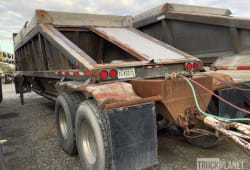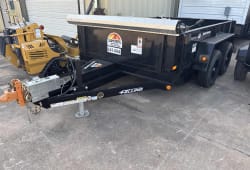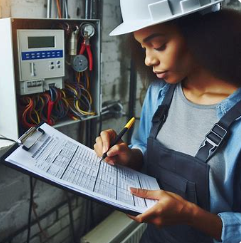The Features of Lowboy Trailers
7 Lectura mínima
)
marzo 7, 2024
Lowboy trailers play a crucial role in the transportation of heavy machinery, serving as the backbone of logistics in construction, mining, and other industries. Their unique design and features make them indispensable for safely and efficiently moving oversized equipment from one location to another.
What Are Lowboy Trailers?
Lowboy trailers are specialized trailers characterized by their low deck height, allowing them to carry tall and heavy loads without exceeding legal height limits. Unlike conventional trailers, lowboy trailers have a deck that sits close to the ground, making them ideal for transporting tall equipment such as bulldozers, excavators, and cranes.
The Importance of Lowboy Trailers in Heavy Machinery Transportation
In industries reliant on heavy machinery, the ability to transport equipment safely and efficiently is paramount. Lowboy trailers offer a reliable solution for moving oversized machinery over long distances, across varying terrains, and through challenging logistical scenarios. Without lowboy trailers, the transportation of heavy equipment would be significantly more complex and costly.
Key Features of Lowboy Trailers
:format(webp))
Load Capacity
One of the primary considerations when choosing a lowboy trailer is its load capacity. These trailers are designed to accommodate heavy loads, with capacities ranging from 40 to 150 tons or more, depending on the model.
Deck Length
The deck length of a lowboy trailer determines the size of equipment it can carry. Longer decks provide more space for larger machinery, while shorter decks are suitable for smaller loads.
Deck Height
The low deck height of these trailers is a defining feature, allowing them to transport tall equipment while maintaining stability and balance.
Detachable Gooseneck
Many lowboy trailers feature a detachable gooseneck, which simplifies the loading and unloading process by allowing the front of the trailer to be removed.
Axle Configurations
Lowboy trailers come in various axle configurations, including fixed, mechanical detachable, and hydraulic detachable. Each configuration offers different advantages in terms of maneuverability, weight distribution, and ease of use.
Suspension System
A robust suspension system is essential for ensuring a smooth ride and minimizing wear and tear on both the trailer and the equipment being transported.
Ramp Options
Some lowboy trailers are equipped with ramps for loading and unloading equipment, while others may require additional equipment such as cranes or forklifts.
Material of Construction
The material used to construct the trailer affects its durability, weight, and cost. Common materials include steel, aluminum, and composite materials.
Benefits of Using Lowboy Trailers
Versatility: Lowboy trailers can transport a wide range of heavy equipment, from construction machinery to agricultural implements.
Safety: The low deck height and sturdy construction of lowboy trailers ensure the safe transport of oversized loads.
Cost-effectiveness: Despite their initial investment cost, lowboy trailers offer long-term savings through their ability to transport heavy equipment efficiently.
How to Choose the Right Lowboy Trailer
Choosing the right lowboy trailer requires careful consideration of several factors, including load requirements, transport conditions, and budget constraints.
Assessing Load Requirements
Before purchasing or renting a lowboy trailer, it's essential to assess the size, weight, and dimensions of the equipment you need to transport.
Considering Transport Conditions
Consider the terrain, road conditions, and climate in which the trailer will be used to ensure compatibility with transport conditions.
Evaluating Budget Constraints
While lowboy trailers offer numerous features and configurations, it's essential to balance functionality with budgetary constraints to find the best option for your needs.
Maintenance Tips for Lowboy Trailers
Maintaining a lowboy trailer is crucial for ensuring its longevity and optimal performance. Here are some detailed maintenance tips to help you keep your lowboy trailer in top condition
Regular Inspections
Conduct thorough inspections of your lowboy trailer at regular intervals. Check for any signs of wear and tear, including cracks, rust, or loose components. Inspect the tires for proper inflation, tread wear, and signs of damage. Pay close attention to critical components such as brakes, lights, suspension systems, and hydraulic systems.
Lubrication:
Proper lubrication is essential for ensuring smooth operation and preventing premature wear of moving parts. Regularly lubricate hinges, pivot points, wheel bearings, and other components as recommended by the manufacturer. Use high-quality lubricants suitable for the specific components and operating conditions of your lowboy trailer.
Cleaning and Corrosion Prevention
Keep your lowboy trailer clean and free from debris, dirt, and corrosive substances. Regularly wash the trailer, especially after transporting heavy equipment or in harsh environmental conditions. Apply rust inhibitors or protective coatings to vulnerable areas to prevent corrosion and extend the lifespan of the trailer.
Tire Maintenance
Monitor the condition of the tires and ensure proper inflation according to the manufacturer's specifications. Inspect tires for signs of wear, cuts, or punctures, and replace them as needed. Rotate tires regularly to ensure even wear and prolong tire life. Proper tire maintenance is essential for the safe and efficient operation of the lowboy trailer.
Brake System Inspection and Maintenance
Inspect the brake system regularly to ensure proper operation and compliance with safety regulations. Check brake pads, drums, rotors, and hydraulic components for wear and damage. Replace worn or damaged brake components promptly to prevent brake failure and ensure safe operation of the trailer.
Electrical System Checks
Test all electrical components, including lights, turn signals, brake lights, and reflectors, to ensure they are functioning correctly. Replace any malfunctioning bulbs, fuses, or wiring harnesses to maintain visibility and comply with safety regulations.
Hydraulic System Maintenance
If your lowboy trailer is equipped with hydraulic systems, inspect hoses, fittings, cylinders, and hydraulic fluid levels regularly. Check for leaks, damaged hoses, or worn seals, and address any issues promptly to prevent hydraulic system failure.
Frame and Structural Integrity
Inspect the frame and structural components of the lowboy trailer for signs of damage, cracks, or fatigue. Welded joints, cross members, and frame rails should be inspected regularly to ensure structural integrity and prevent catastrophic failure during operation.
Documentation and Record-Keeping
Maintain detailed records of maintenance activities, inspections, and repairs performed on the lowboy trailer. Keep track of service intervals, replacement parts, and any modifications made to the trailer. Proper documentation ensures compliance with regulatory requirements and helps identify maintenance trends or recurring issues.
By following these maintenance tips and guidelines, you can ensure the safe, reliable, and efficient operation of your lowboy trailer while maximizing its lifespan and minimizing downtime and repair costs. Regular maintenance is essential for preventing accidents, ensuring compliance with safety regulations, and preserving the value of your investment in heavy equipment transportation.
Common Misconceptions about Lowboy Trailers
Despite their widespread use, there are several misconceptions about lowboy trailers, including concerns about stability, maneuverability, and legal compliance.
Future Trends in Lowboy Trailer Design
As technology advances and customer demands evolve, the design of lowboy trailers is expected to continue evolving to meet the needs of modern transportation challenges.
Conclusion
Lowboy trailers are indispensable tools in the transportation of heavy machinery, offering a safe, efficient, and cost-effective solution for moving oversized equipment. By understanding the key features, benefits, and considerations associated with lowboy trailers, businesses can make informed decisions when choosing the right equipment for their transportation needs.
FAQs
Are lowboy trailers suitable for all types of heavy equipment?
Yes, lowboy trailers are designed to transport a wide range of heavy equipment, including construction machinery, agricultural implements, and industrial equipment.
How do I determine the load capacity of a lowboy trailer?
The load capacity of a lowboy trailer is determined by factors such as axle configuration, deck length, and construction materials. It's essential to consult the manufacturer's specifications and guidelines to ensure compliance with load requirements.
What are the advantages of a detachable gooseneck?
A detachable gooseneck simplifies the loading and unloading process by allowing the front of the trailer to be removed, providing easier access for equipment placement.
How often should lowboy trailers be inspected and maintained?
Lowboy trailers should be inspected and maintained regularly, following the manufacturer's guidelines and industry best practices. Regular inspections help identify and address potential issues before they escalate into costly repairs or accidents.
Can lowboy trailers be customized to suit specific transportation needs?
Yes, many manufacturers offer customization options for lowboy trailers, allowing businesses to tailor the design, features, and specifications to meet their specific transportation requirements.

Post acquisition of Boom & Bucket, the company he founded, Adam now leads Marketplace Growth for Ritchie Bros.














